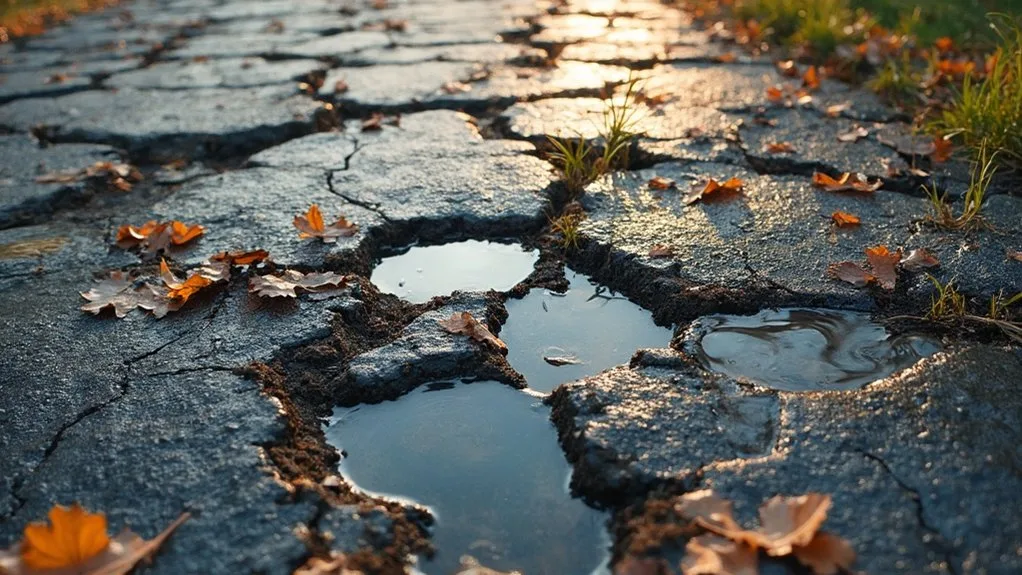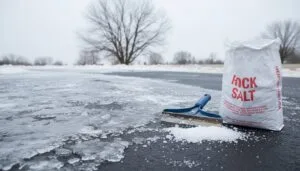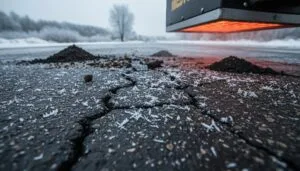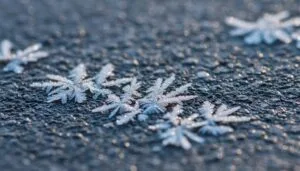Don’t let winter wreak havoc on your asphalt! Watch for these five critical warning signs that scream “repair needed now.” Check for widening cracks bigger than 1/4 inch – they’re trouble spots for freeze-thaw damage.
Notice water pooling after rain? That’s a red flag for drainage issues. Fading and discoloration mean your surface protection is wearing thin. Uneven spots suggest deeper structural problems that’ll only worsen with frost.
And those crumbling edges? They’re practically inviting winter moisture to cause serious damage. Let’s investigate exactly what you can do to protect your pavement investment before the cold hits.
Key Takeaways
- Visible cracks wider than 1/8 inch require immediate repair to prevent water infiltration and freeze-thaw damage during winter months.
- Standing water or puddles after rainfall indicate poor drainage, which can create hazardous ice patches in cold weather.
- Surface raveling, where aggregate particles loosen and detach, signals weakened asphalt that’s vulnerable to winter weather damage.
- Potholes must be repaired promptly, as freeze-thaw cycles will significantly worsen their condition during winter.
- Crumbling edges and corners require immediate attention, as water infiltration during winter freeze-thaw cycles accelerates deterioration.
Widening Cracks and Surface Gaps
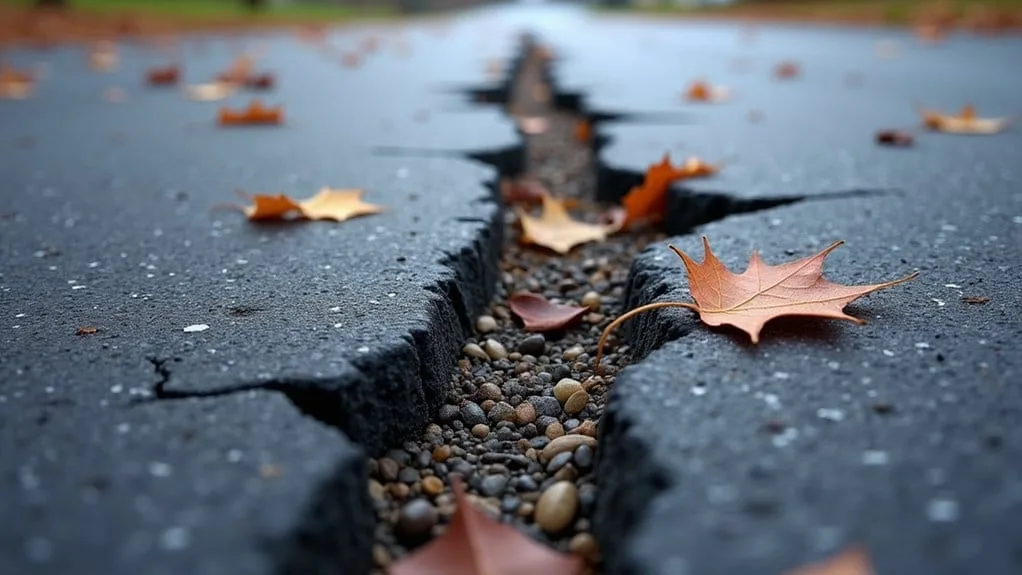
During the winter months, small cracks in your asphalt driveway or parking lot can quickly become major problems. Freezing temperatures cause existing cracks to expand as water turns to ice. UV radiation damage can accelerate deterioration if left untreated. You’ll want to address these issues before they evolve into expensive repairs! Regular maintenance can extend driveway lifespan and prevent costly repairs.
Don’t wait for a crack assessment – here’s what to watch for:
- Cracks wider than 1/8 inch need immediate attention
- Cross-hatching cracks signal serious underlying issues
- Surface distortions suggest base layer problems
- Water seepage beneath the asphalt – a huge red flag!
Let’s talk repair techniques you’ll need:
For cracks between 1/8 inch and 1 inch:
- Professional crack filling with asphalt-rubber mix
- Seal coating to protect against elements
- Patching for any developing potholes
Timing is everything! Schedule repairs when:
- Temperatures are at least 50°F
- Weather forecast shows less than 40% chance of rain
- You’re within spring-to-fall maintenance window
Remember – what starts as a tiny crack today can become tomorrow’s costly repair. Your asphalt’s crying out for attention!
Don’t let winter catch you unprepared. Take action now to protect your investment.
Water Pooling After Rainfall
Vigilance after rainfall can reveal critical problems with your asphalt surface. Don’t ignore those puddles! They’re red flags for serious drainage issues that can wreck your pavement.
Here’s what you need to watch for when water pools:
| Warning Sign | What It Means |
|---|---|
| Standing Water | Your surface has poor drainage slopes |
| Multiple Puddles | Base layers may be settling unevenly |
| Persistent Pools | Clogged drainage systems need attention |
| Edge Water | Improper grading requires correction |
You’re facing a ticking time bomb when water sits on your asphalt. Moisture damage starts immediately! The water seeps into tiny cracks and begins its destructive work. During winter, this trapped moisture freezes and expands. Crack! There goes your pavement. Poor compaction during installation often intensifies these drainage problems. Regular commercial parking lot sealing is crucial to maintaining your asphalt’s integrity.
Don’t wait for extensive damage to occur. Take action now:
- Schedule professional drainage assessments
- Clear all blocked gutters and drains
- Repair small cracks before they grow
- Consider infrared patching for uneven areas
Remember: Every hour of standing water puts your asphalt at risk. Proper drainage isn’t just about preventing puddles – it’s about protecting your investment! Act fast to avoid costly winter repairs.
Fading and Discoloration

Beyond water damage, your asphalt faces another visible threat: fading and discoloration. Your once-black pavement can change into an unsightly gray or brown surface over time.
What’s Causing the Color Change?
- UV rays are attacking your asphalt’s molecular structure daily
- Oxidation occurs when air and moisture break down the surface
- Vehicle fluids and pollutants create stubborn stains
- Heavy traffic wears away the rich, dark appearance
Professional road safety experts recommend using reflective materials to enhance visibility on faded surfaces, especially in low-light conditions. Regular seal coating from professionals like Nathan’s Paving & Seal Coating can help restore your asphalt’s original appearance.
Why It’s More Than Just Looks
Don’t dismiss this as a purely cosmetic issue! Fading signals that your asphalt’s protective properties are weakening.
When color fades, your pavement becomes more vulnerable to:
- Cracking and brittleness
- Water penetration
- Further deterioration
- Structural weakness
Taking Action
Your asphalt needs both color restoration and surface protection before winter hits.
Regular sealcoating creates a protective barrier against:
- Harmful UV rays
- Chemical spills
- Oxidation damage
- Weather exposure
Don’t wait until your pavement turns completely gray! Early intervention can prevent deeper structural issues and extend your asphalt’s lifespan greatly.
Uneven Pavement Spots
Those uneven spots in your asphalt aren’t just annoying bumps and dips – they’re warning signs of deeper problems that need immediate attention. Your pavement maintenance strategy needs to address these issues before winter makes them worse!
Let’s look at what causes these pesky spots and how to handle them:
| Problem | Action Needed |
|---|---|
| Frost Heave | Professional inspection and subgrade repair |
| Poor Installation | Compaction testing and possible repaving |
| Weather Damage | Surface patching and sealcoating |
| Drainage Issues | Grade correction or drain installation |
| Base Failures | Complete section replacement |
You’ll need to act fast! These repair techniques become more challenging once temperatures drop.
Here’s why:
- Water seeps into small cracks and freezes
- The freeze-thaw cycle creates bigger problems
- Poor drainage leads to ice formation
- Existing uneven spots collect more water
Don’t wait until it’s too late! Schedule professional repairs now. A small investment in fixing these spots can prevent major expenses later. Remember: Winter weather will only amplify existing pavement problems. Your quick action today protects your asphalt investment tomorrow! Additionally, addressing these issues early can significantly extend the lifespan of your pavement, ensuring increased lifespan of existing pavement and saving you money in the long run.
Crumbling Edges and Corners
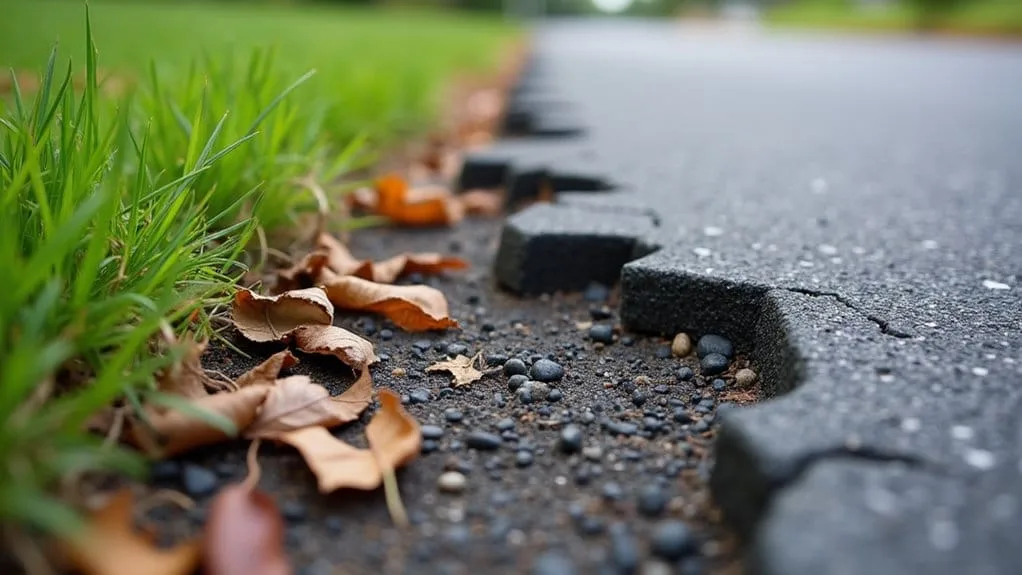
Along the perimeter of your asphalt surface, crumbling edges and corners signal serious structural concerns that demand immediate attention before winter arrives.
These deteriorating areas often start with minor cracks but can quickly escalate into major problems. You’ll notice the surface beginning to flake and crumble, especially in high-traffic zones.
Don’t ignore edge deterioration! It’s not just about aesthetics – it’s a safety issue. When edges start failing, they create hazardous conditions for both vehicles and pedestrians. Water infiltration will make things worse, especially during freeze-thaw cycles.
Here are three critical maintenance tips to protect your asphalt edges:
- Schedule monthly inspections to catch early warning signs
- Apply sealcoating before winter hits to create a protective barrier
- Address any existing cracks immediately – don’t wait until spring!
Your prompt attention to crumbling edges now will save you thousands in repairs later. Regular maintenance, such as seal coating, significantly extends the lifespan of your pavement.
Watch for uneven or raised edges, and keep the perimeter clear of debris.
Remember: winter’s harsh conditions will only accelerate existing damage. Take action now to protect your investment and guarantee safety throughout the cold season!
Conclusion
Think of your asphalt like a winter coat – it needs to be strong and intact before harsh weather hits! Don’t wait until your driveway looks like Swiss cheese. You wouldn’t leave your house without proper protection, so don’t leave your pavement vulnerable either. Take action now on these warning signs. Your future self will thank you when spring arrives and your asphalt is still smooth, solid, and damage-free.
Protect Your Asphalt Before Winter Hits Central PA!
As winter looms, your asphalt surfaces deserve immediate attention! Look for signs like standing water or uneven spots that can lead to severe damage when temperatures drop. At Nathan Paving, we provide expert assessments and top-notch repair services to safeguard your pavement investment. Don’t let the season catch you off guard—request your free quote today!
Explore our services for driveway patching and new driveway installation to keep your property looking its best all year round. Contact us to get your free quote and check out our driveway patching and new driveway installation options.
